Peru’s qualification for the 2018 World Cup in Russia was their first in 36 years. The national side’s average age was 27.4 years old. Along with younger players such as Celta Vigo’s Renato Tapia and Edison Flores, for DC United in the MLS; the key players are now 30+. This is especially true in the forward line. The 3 strikers in the squad were Paolo Guerrero, now 36, Jefferson Farfan, now 35, and Raul Ruidiaz, now 30.
Paolo Guerrero has been Peru’s leader, on and off the field, for many years. The former Budesliga player with Bayern Munich and Wolfsburg is their captain and all time leading scorer with 38 goals. He continues to lead the line for ‘La Selección’ though at 36 years of age, successors to the role are required. Replacing a legend is a difficult task for national side manager Ricardo Gareca.
With the opening stages of World Cup 2022 qualification looming, the search for alternate options in the centre forward position becomes vital. Guerrero will continue to be part of the squad as long as fitness allows while entering his late 30’s. Alternate options will need to be ready to use and adapted to the style of play required from Gareca. Raul Ruidiaz has been a prolific goal scorer at club level. At Seattle he has 29 goals in 47 games; at Morelia in Mexico he had 40 goals in 72 games and 22 goals in 22 games for Universitario in Peru. Despite this, in the national side he has struggled to adapt to the tactics and style of play, especially under Gareca. He has only four goals in 43 appearances for Peru.
This tactical analysis identifies 2 players as the front runners for the centre forward role in Gareca’s lone striker system. Marco Aldair Rodriguez, who has recently moved on to America de Cali from last season Peruvian champions Binacional is the more experienced at 26 years of age. The other, is Matias Succar, 21, whose contract at Peruvian side Deportivo Municipal expires at the end of 2020.
Line Ups
Analysis of his time in charge shows Gareca favours a 4-2-3-1 formation when setting up his side. Peru’s wide players are not without defensive duties. His system is fluid to ensure it can change to a 4-4-1-1 or even a 4-1-4-1 formation when looking to defend deep. This can at times leave the striker isolated up the pitch. Peru will look to counter attack with pace; though it is vital the striker can maintain possession and link up play.
Defending from the front
World Cup qualification in South America consists of awarding 4 automatic places and 1 play off place. 10 nations compete, including regular qualifiers Brazil, Argentina and Uruguay. Peru is often competing as the underdog. As just mentioned previously, Guerrero can often be isolated up front when Peru is using a counter attacking system.
He is a key outlet for Peru who will look to hold up the ball, often under pressure from an overloaded defence. Peru relies at times on his strength and determination to win possession and bring others into play. As visible below, he is not just affecting play in the final third. He intercepts and counter presses across the middle and final thirds. His contributions are not narrow, he will work across the pitch from side to side.

Guerrero uses his physical strength well, which often energises the crowd and players around him. Both Marco Aldair Rodriguez and Matias Succar have similar builds to Guerrero. Both are 184cm tall and 79kg and 76kg respectively. When leading from the front, Gareca’s centre forward will be involved in offensive duels, looking to hurry and force defences into mistakes. Guerrero is often used as the target for long goal kicks, where he will compete aerially.
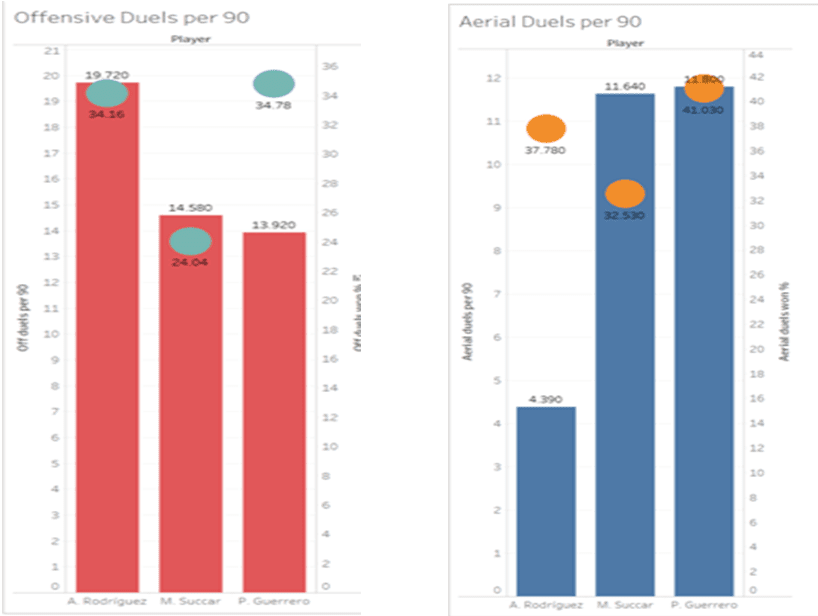
Marco Aldair Rodriguez has played a similar role at Binacional. After winning the Peruvian Primera he has also competed well in the Copa Libertadores in this system. He does not compete aerially as much as the other 2 strikers, though has a similar percentage won. However, Rodriguez does average more offensive duels than Guerrero and Succar. At 19.72 per 90 he is averaging over four offensive duels per game more than Guerrero. It is clear though, from this, that Binacional do not use a system that requires Rodriguez to duel aerially. As can be seen below, Rodriguez will continue to be a focal point for Binacional and work hard in the middle and final third out of possession.
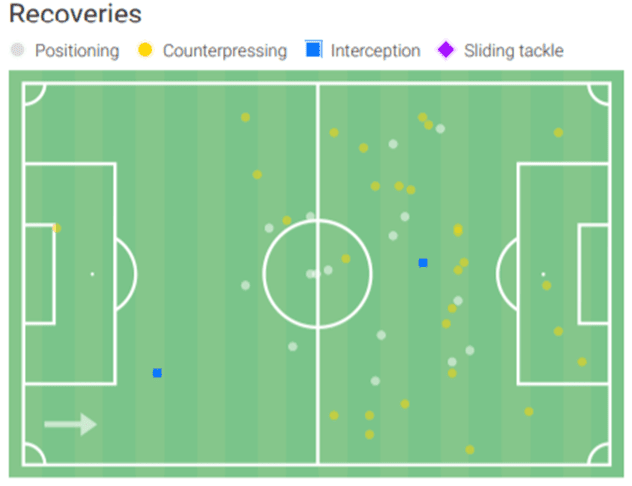
In contrast to the Succar is a player who works on regaining possession all across the pitch.

Succar is less experienced and could be considered to be trying to fulfil every role rather than focusing on being a target and a leader from the front. This can be similarly compared with Dominic Calvert-Lewin at Everton. The start of this season has seen him in strong goal scoring form due to keeping to his role in the side leading from the front. Succar’s recovery contributions are more scattered across the pitch than Guerrero and Rodriguez’s. This can be due to his inexperience, as well as the styles of play of their respective sides.
What is evident is that Succar’s offensive duels and aerial duels stats are very similar to Guerrero’s. Rodriguez out scores them both in his offensive duels per 90, though contributes much less in aerial duels.
Movement off the ball
Guerrero will also cover a lot of ground while his side are in possession as well. In order to find space to receive the ball he will work across the pitch from left to right, not just in central areas.
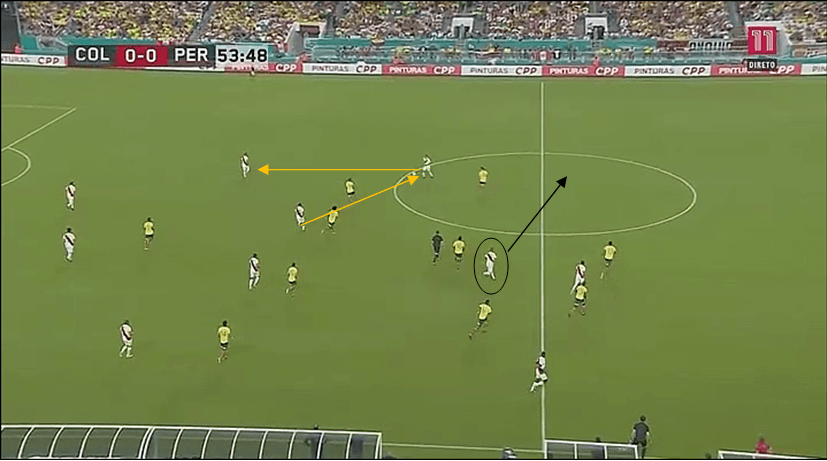
The above image shows the Peruvian left forward receiving a pass and playing back to the left-back. As the ball is played to the left forward, Guerrero has already seen an opportunity to find space and disorganise the Colombian defensive line. As play has been switched from the near side to the far side, the Colombian right-back has pushed up onto the Peruvian player receiving the first pass. Guerrero sees the opportunity if the ball is played back to the left-back to receive a long pass forward and stretch the defensive line. He will take a central defender with him who will look to close him down – this can separate the two central defenders of Colombia. Space is then created for runners coming from deep with the Colombian defence stretched across the pitch.
This is a key part of Peru’s tactics – to find space to counter-attack and exploit. Guerrero´s intelligence to move defenders around and find space for himself, and others, was key in Peru´s qualification for the World Cup in 2018.
Alongside moving across the pitch, Guerrero shows his quality in finding areas in the final third to receive the ball in dangerous areas. Being able to identify areas where defenders are vulnerable, Guerrero can move without needing to sprint across the pitch. Below, the image shows Guerrero has seen the Chile left centre-back move towards the ball as Peru attack. He is able to move away from the right centre-back while staying onside.
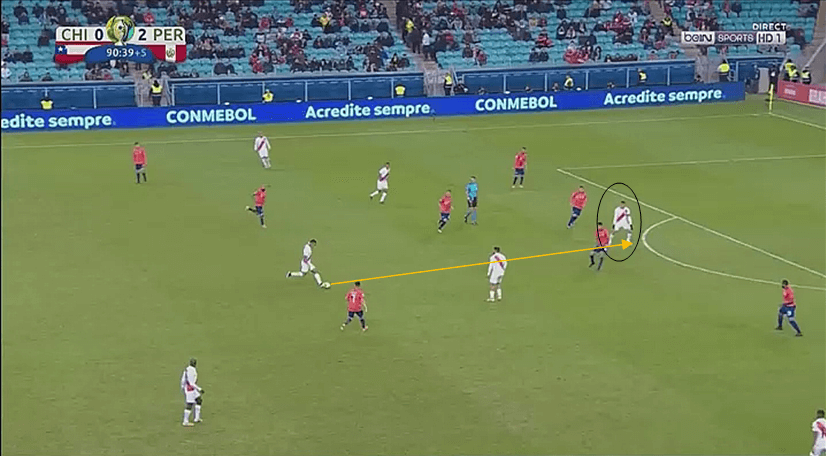
As the ball is played through, Guerrero is able to control and use his body to shield the ball from the defender closing him down. He allows the ball to come across his body and is in a position to go one on one with the goalkeeper and ultimately score.
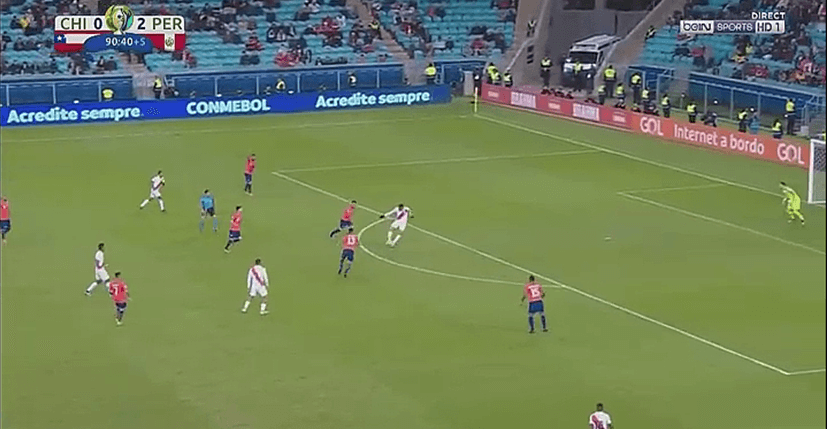
Rodríguez has great pace and strength which Binacional used to great effect. When making himself available for through passes, he finds space between defenders well. This was evident in Binacional’s 2-1 victory over Brazilian side Sao Paulo.
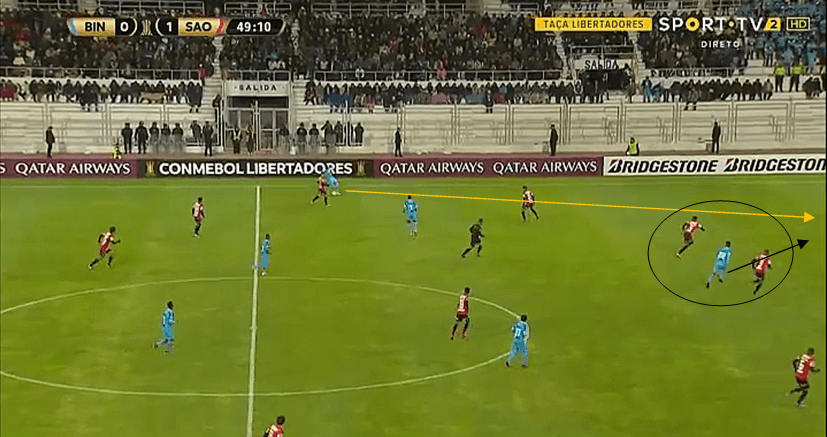
The right sided central defender cannot keep focus on both the ball and Rodríguez due to his positioning on his back. The other central defender is in a position to see both the ball and Rodríguez. Although, once the ball is played, Rodríguez is able to run in front and across the defender to receive the pass. This leads to a goal, where he is able to use strength and speed to enter the box, hold of his defenders and score from a tight angle.
Rodríguez is also able to move in an intelligent manner to free up time and space for players on the ball, as well as get himself into goal-scoring opportunities. As a clearance is charged down and a turnover forced, Rodríguez reacts quickly. His movement comes across the left sided central defender who lost possession.
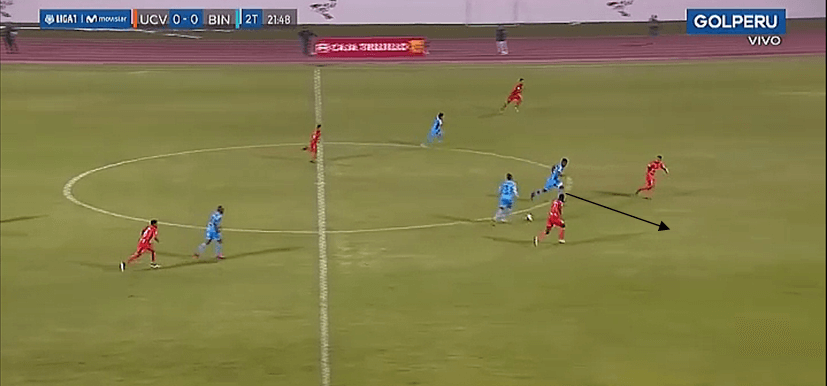
This ensures that it delays his opponents press on the Binacional player on the ball. Rodriguez also makes use of his pace to outrun the right sided central defender and move into a position to receive a pass.
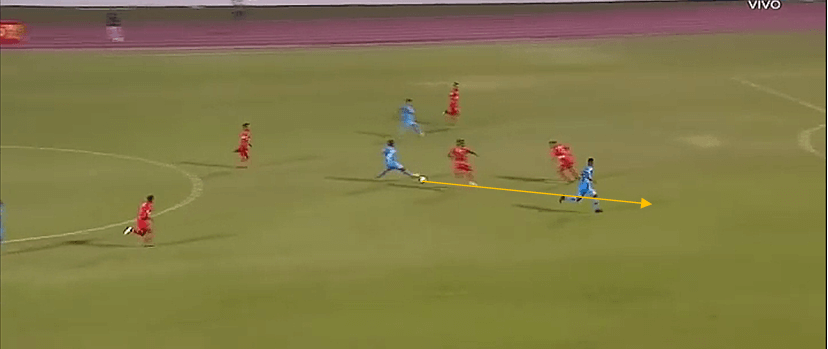
Due to delaying the counter press, both central defenders are both focused on the player with the ball. The right sided centre-back was forced to position himself to try to block and delay the player on the ball.
Succar´s role in Municipal sees him as a focal point of the attack as well. He is strong, quick and aggressive. He is also confident and used frequently with passes to feet in congested areas. Succar can drop in front of the defensive line and attract attention from more than one player. Below we can see three players surrounding Succar as he receives the pass.

Succar is able to find a teammate, and as we can see below, continues his movement to receive.
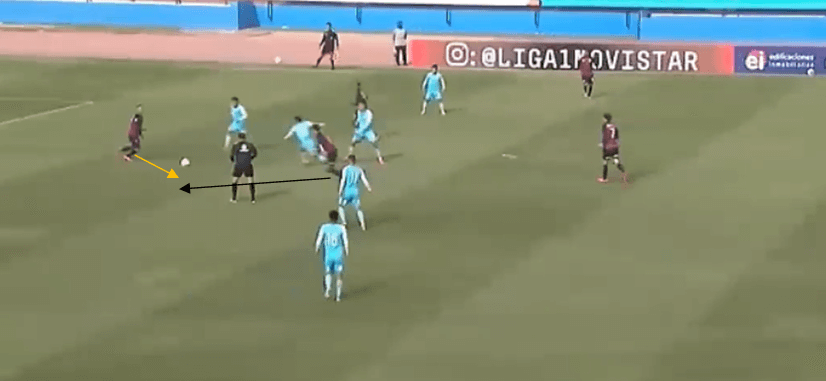
Along with Guerrero and Rodriguez, Succar is able to think quickly and put himself in positions to receive the ball. In this specific situation he is able to attract three defenders and then find space with a quick pass and move. Succar is then able to move towards goal and shoot.
Along with dropping deep, Succar has speed to move into space and stretch defensive lines. He is able to time his run well while positioning himself well to be difficult to mark.
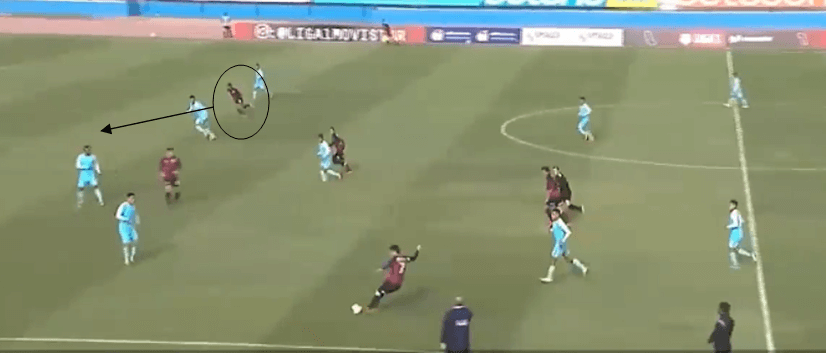
Succar identifies areas to position to then sprint into areas behind the defensive line. Starting slightly wider, he moves in between the left back and left centre back. This becomes difficult for the centre back to monitor Succar’s movement as well as keep an eye on the ball. This movement and awareness is vital for a centre forward to be able to control an attack and put pressure on the defenders.
Finishing and Goals
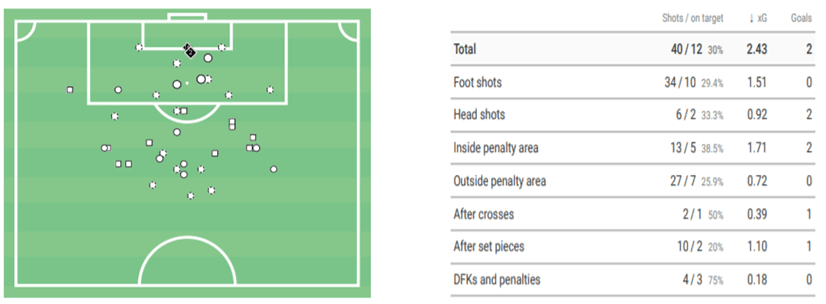
The above image and stats show Peru’s shooting and finishing from their past six matches. Both goals were scored by the central defenders from headers in the box. Peru has averaged two shots on target per match. These matches have been against tough opposition and seen them play as underdogs – against Brazil, Uruguay and Colombia. In those games, we have seen Peru relying on counter-attacking play where possible. More shots have come from outside the box, often due to the fact that the centre-forward can be isolated or the attack has started from deep and defenders have been able to block off routes to the penalty box.
Guerrero has been able to adapt and perform in this role and become the country’s leading scorer. He is confident in the box as well as scoring from range over his career. The following table shows Guerrero’s shooting and scoring statistics from the 2019/20 season.
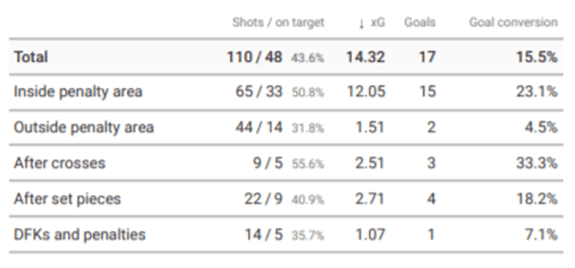
As can be seen, his xG was 14.32 and he has over achieved, scoring 17. 15 of these have come inside the box and only two from outside. With only nine shots after a cross, it is clear that Guerrero often receives the ball from through passes or receives in front of the defence before moving into the box or shooting from range.
Rodríguez’s shooting also comes in similar positions to that of the Peru national team shots. The image below shows all but one shot coming within the width of the penalty box. Most goals are scored outside the six yard box, but inside the eighteen yard box.
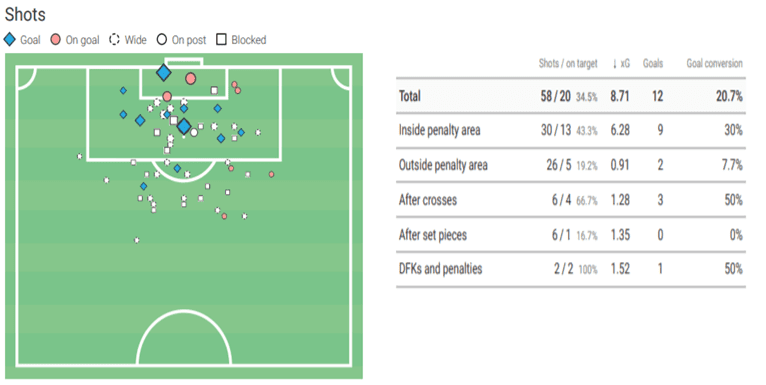
Rodriguez has a better goal conversion percentage, 20.7%, than Guerrero’s 15.5%. He has had fewer shots but their goals outside the penalty area and from crosses are the same.
Matias Succar also has found success centrally with goal scoring. All of his attempts have been from within the width of the eighteen yard box.
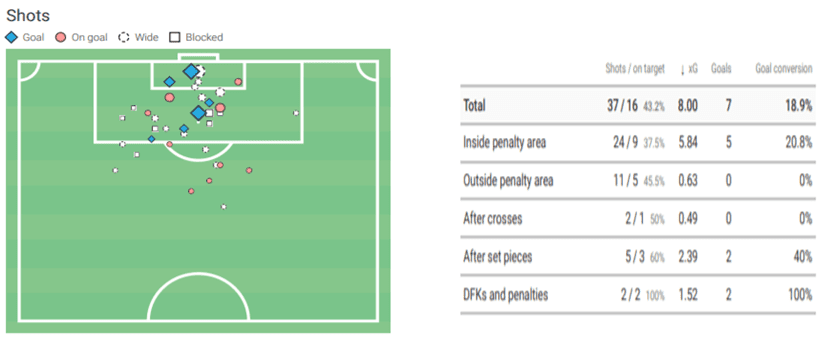
He is the only player of the three to have scored less than his total xG. All of his goals have come from within the eighteen yard box and none from crosses. While Succar may have less goals he does provide a strong threat from set pieces. Peru’s only two goals in the last six games have come from central defenders from set pieces. Succar provides a goal scoring threat in these positions as well. From set pieces, 60% of his shots have been on target, scoring two goals from five shots.
Conclusion
Opportunities for the centre-forward can be limited per match while in the Peruvian National Side. It is vital for a player to work hard in and out of possession. There is no replacing the legacy of Guerrero straight away. His importance to the side is not just in his performance. Gareca will have to address this separately.
For the strikers, both Rodríguez and Succar have experience playing in a similar style to Guerrero. Rodríguez is building more experience against stronger sides in the Libertadores and now moving to the Colombian league. He will continue playing Libertadores football with America de Cali.
Succar has only experienced Peruvian league football. His contract is expiring at the end of 2020 and will be looking for a move to a bigger club. At 21 he is the more inexperienced player, though with guidance he will continue to develop into a future star for the national team.
Gareca has called up Rodríguez to work with Guerrero in the squad for the qualifiers and will help transition to the future as Guerrero moves closer to retirement. Peru now have two strikers who could adapt to the style of play Gareca uses. Rodríguez will look to impress this time around while Succar will look to a new club for 2021 in a stronger league to force his way into Gareca’s plans.

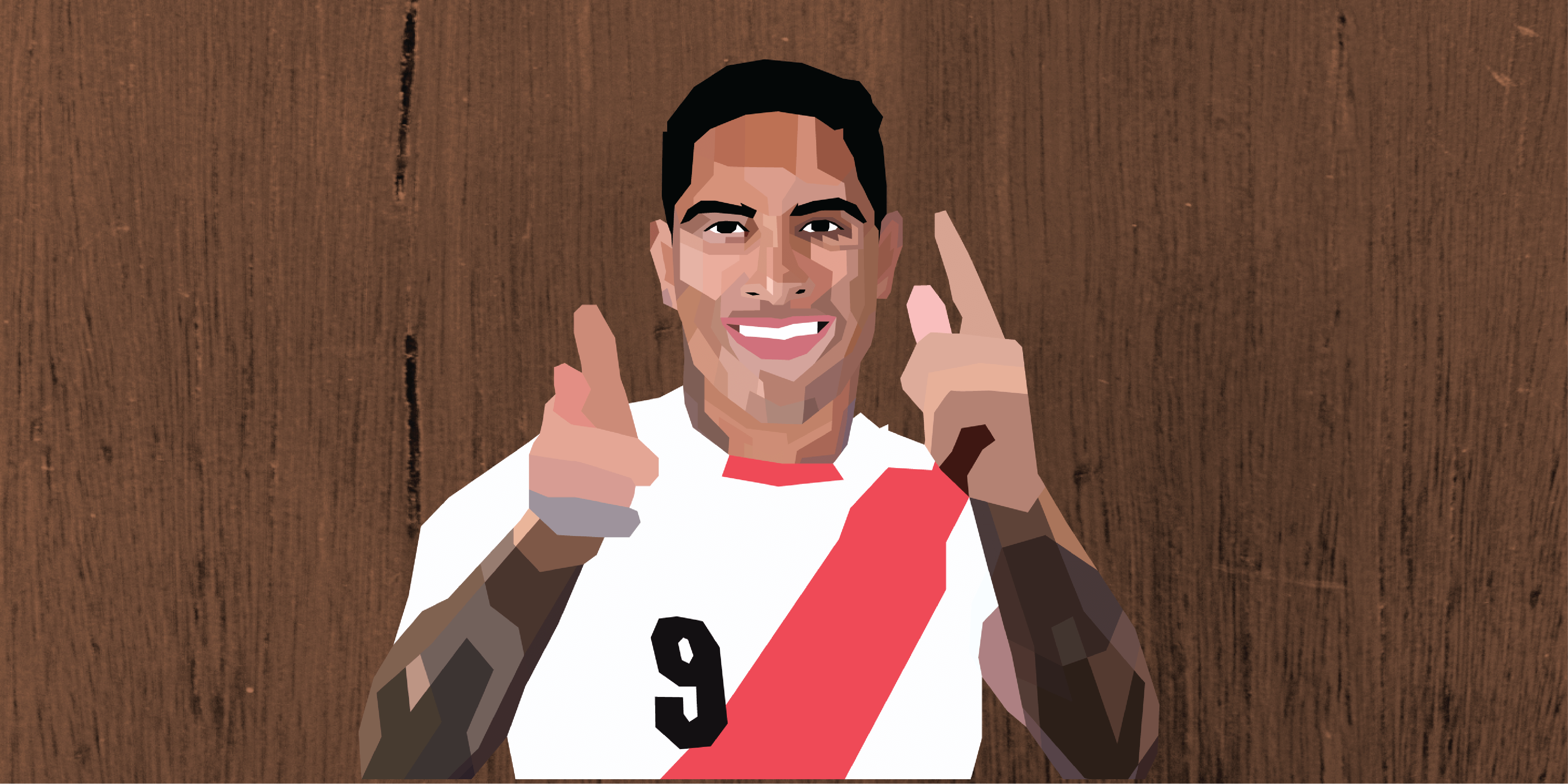



Comments